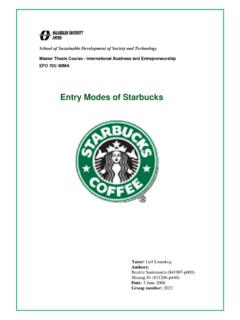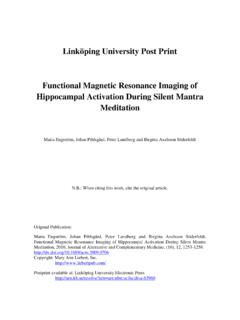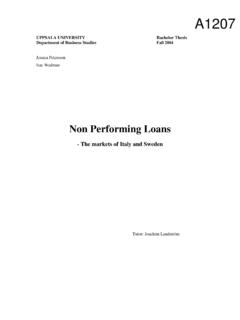Transcription of Factors that influence consumer purchasing decisions of ...
1 ` School of Business, Society and Engineering Bachelor thesis in in Business Administration FOA214 (15 credits) Factors that influence consumer purchasing decisions of Private Label Food Products A case study of ICA Basic Thu Ha, Nguyen 900524 Ayda Gizaw 830902 1/13/2014 ` Abstract Course: Bachelor Thesis in Business Administration Institution: School of Business, Society and Engineering Authors: Thu Ha, Nguyen & Ayda Gizaw Examiner: Eva Maaninen-Olsson Supervisor: Magnus Linderstr md Title: Factors influence consumer purchase decisions of Private Label Food Products Keywords: Private Label Brand, consumer attitudes, intention, perceptions, ICA Basic Abbreviations PLB: Private Label Brand, WOM: word of mouth Research questions: Which Factors influence consumers buying decisions of low-price PLBs food products?
2 How consumers perceive low-price PLB food product? Case study of ICA Basic Research purpose: The purpose of this study is to identify and analyze Factors that influence consumer purchasing decision of private label food products. Method: In this case study, both secondary data and primary were utilized. Secondary data was obtained from relevant literatures, online journals, articles, blogs, and other electronic sources. The primary data was collected by the combination of quantitative and qualitative approaches. Qualitative data was carried out through interviews with store manager of ICA Skrapan, V ster s and with ICA PLB manager; quantitative data were collected through online survey, designed on the platform providing by the commercial website Conclusions: The research identified five Factors that influence consumers' purchase decision of low-price private label brands are brand, brand related activities (advertisement & word of mouth), perception, attitude, purchase intention and demographic Factors .
3 The study proved brand and brand related Factors are not significant Factors that influence purchase intention. However, for food products, price-quality relationship is the most important factor. If consumer perception of quality and price match their expectation, they will be satisfied and perceived high value for the products. However if the consumers are dissatisfied with the product, they perceive risk and that has negative impact on their purchase decision . The study also showed female buy more low-price private label compare to male and those ` who earn low income also buy more low-price private label compared to ones with higher incomes. Further the result showed a positive attitude towards the ICA brand have a positive influence on buying of the PLB. ` Acknowledgement Firstly, we would like to express our gratitude to our supervisor Mr Magnus Linderstr m who has been constantly giving us helpful advices and orientation during our thesis process.
4 Secondly, we would like to thank ICA Skrapan Manager and ICA Private Label Manager for their sincere participations in the interviews; and thank for our 226 respondents who spent their time fill out the surveys. Finally, we are thankful to our families and friends for their sincere supports during this period. We also would like to thank our opponents and group mates for all the constructive criticism and recommendations that helped us to develop and improve our research. ` Table of content 1. Introduction .. 1 Background .. 1 consumer behaviour .. 1 Private Label Brand .. 2 ICA Super market-PLBs .. 3 ICA Basic .. 3 Problem discussion .. 3 Purpose of this Research: .. 4 Research question .. 4 Target Groups .. 5 Delimitations .. 5 2. Literature Reviews & Theoretical Framework .. 6 Previous studies .. 6 Theoretical framework .. 6 Branding .. 8 Definition of brand.
5 8 Branding strategies .. 8 Brand Equity .. 9 Brand Awareness .. 10 Brand familiarity .. 11 Perceptions .. 13 Perceived Price .. 13 Perceived Quality .. 14 Perceived Risk .. 15 ` Perceived Value .. 16 Satisfaction & Dissatisfaction .. 17 Attitude .. 18 Intention .. 19 Demographic Factors .. 20 Age .. 20 Gender .. 20 Income .. 20 3. Methodology .. 21 Choice of the topic .. 21 Research approach .. 21 Data collection .. 22 Secondary data .. 22 Primary Data .. 22 Survey .. 24 Snow ball Sampling .. 26 Research criteria: Validity and reliability .. 27 4. Empirical Findings and Analysis .. 29 ICA Basic .. 29 Interview data .. 29 Interview with ICA store manager .. 29 Interview with ICA Private Label Manager .. 30 Survey data & analysis .. 31 Brand and related Factors .. 34 Brand familiarity .. 37 Brand equity, branding strategies .. 42 Risk Perception .. 44 ` Price Perception .. 46 Perceived Quality.
6 47 Perceived Value .. 51 Satisfaction .. 52 Demographic factor of buying PLBs (ICA Basic) .. 53 Attitude .. 55 Purchase intention .. 57 Are consumers willing to pay for more? .. 59 Analysis and Findings Summary .. 60 5. Conclusions .. 63 Conclusion of the study .. 63 Recommendation and future researches .. 64 Managerial Suggestion .. 65 6. Bibliography .. 66 Reference from interviews .. 71 Reference from websites .. 71 APPENDIX-1 .. 75 APPENDIX-2 .. 76 APPENDIX-3 .. 77 List of Figures and Tables Figure 1 Theoretical framework .. 7 Figure 2-Relation between Perceived Price,Quality,Value and Risk .. 16 Figure 3- Gender .. 32 Figure 4- Age .. 33 Figure 5-Attitude .. 33 Figure 6-Brand Awareness .. 34 Figure 7-Brand familiarity ,Advertisment, WOM .. 35 Figure 8-Brand familiarity .. 38 ` Figure 9-Brand familiarity .. 39 Figure 10- Satisfaction .. 41 Figure 11-Attitude towards ICA Basic .. 42 Figure 12-Brand Equity .. 42 Figure 13-Perceived Price.
7 47 Figure 14- Perceived Quality .. 48 Figure 15-Perceived Quality .. 50 Figure 16 -Satisfaction .. 53 Figure 17-Relationship between ICA Basic and Gender .. 54 Figure 18-Attitude towards ICA basic .. 57 Figure 19-Intention to buy ICA Basic .. 58 Figure 20- Would like to pay slightly more for improvements .. 59 Table 1- Operationalization .. 26 Table 2- Brand Awareness .. 35 Table 3-Perceived risk .. 46 Table 4- Perceived Price .. 46 Table 5-perceived quality and perceived risk relationship .. 51 Table 6-Value perception .. 51 Table 7- Relationship between perception of Value and risk .. 52 Table 8-Relationship between ICA Basic and Income .. 55 Table 9-Word of mouth .. 55 Table 10-Purchase intention .. 58 ` 1 1. Introduction This section comprises a brief description of consumer behaviour, private label, research topic area, ICA super market. Then it continues with problem definition, purpose of the study, strategic question, target groups and delimitations.
8 Background consumer behaviour Nowadays companies are more concerned on individual consumer behavior. It helps them to yield information about how the consumers think, feel and choose their products. Every individual is consumer . consumer behavior is the study of the processes involved when individual or groups select, purchase, use, or dispose of the product, service, ideas or experiences to satisfy needs and desires ( Michael , 1998, p. 31). The expand view of consumer embrace much more than the study of why and what consumer buy, but also focuses on how marketer influence consumers and how consumers use the products and services. Customers are in a tough spot. Individuals have exposed to different window of information and varieties of products; many great deal of choices and options available in the market place impulse their purchase decision . However the interpretation and decision making is different among individuals and also influenced by internal consumer behavior (perception, altitude, and motivation) and external Factors (family roles, peer influence and group influence ).
9 Supermarket is one of an interesting area for the study where features of consumer behavior can easily be seen. Focusing on food products, which are needed by the consumers in daily basis, give the impression that the consumers have little thought in purchasing than other product like cloths, mobile phones and cars. Nevertheless, consumers are exposed to variety of food product types which is diversified in price, quality, packages and size. While a person does his shopping on a typical Sunday morning, he enters the local super market with a basket on hands, scans for a cereal box, he grabs one, checks out the box carefully, puts it back to the shelf; eventually, he/she picks up the other box lies next to it; it takes him two So, what persuade shoppers on randomly or intentionally selecting food products? What decide them to buy or not to buy? The study of consumer behavior will help to explain such type of buying behavior.
10 Furthermore consumer and buyer behavior is in fact an ongoing process, ` 2 not merely indicates the interaction between consumers and producers at the time of purchase but it includes various stages in the consumption process: pre purchase issue, purchase issues and post purchase issues. (Solomon, 2013, p. 32) There are two perspectives on consumer research should be discussed, which are two type of approaches: Positivist approach and Interpretivist approach. Whilst positive approach( sometimes called modernism) emphasizes that human reason is supreme and there is a single, objective truth that science can discover; in interpretivism approach( or so-called postmodernism) , the interpretivist emphasizes the important of symbolic, subjective experience and the idea that meaning is in the mind of the person- in other word individuals construct their own meanings base on individuals own unique and shared cultural experiences, therefore there is no right or wrong answers.










